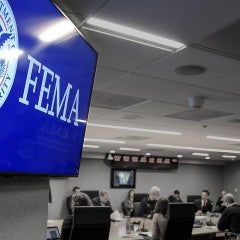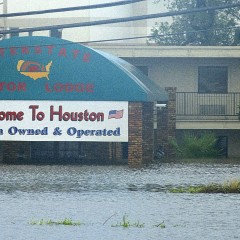Ike was directly or indirectly responsible for 28 fatalities in Harris County and 17 in Galveston County, according to data compiled by the Centers for Disease Control and Prevention. It caused an estimated $27 billion of damage — $41.7 billion adjusting for inflation — and is ranked as the ninth-costliest tropical cyclone in U.S. history, according to the National Centers for Environmental Information. At the time, it was the third-costliest behind hurricanes Katrina and Andrew.
Central to the region’s preparation and recovery from Ike, and a prominent figure throughout the disaster, was then-Harris County Judge Ed Emmett.
Emmett was unanimously elected to the position by the Harris County Commissioners Court in March 2007, following the resignation of Robert Eckels. When he assumed his duties, Emmett was referred to as a “somewhat obscure former Texas legislator” and a “relatively unknown political insider” in reports by the Houston Chronicle and Houston Public Media.
Eighteen months into the role, Emmett faced his first of several major disasters as county judge.
The Urban Edge spoke with Emmett, now a fellow in energy and transportation policy at Rice University’s Baker Institute for Public Policy, to discuss his experience with Hurricane Ike. The interview has been edited for length and clarity.
When did you first become concerned about Ike as a threat to Harris County and the surrounding area?
Mark Sloan, the Homeland Security and Emergency Coordinator for Harris County, and I were at the White House receiving an award for work Harris County had done. After we get our award, we’re sitting in Reagan National Airport and there was a storm out in the gulf. I asked him, “What do you think?” He goes, “I think we’re in trouble.” This was on Tuesday and the storm hits that weekend. He was absolutely right, so we hustled back and started preparations.
What guided preparations for Hurricane Ike?
The lessons learned from Katrina and Rita were absolutely critical. With Katrina, everyone saw the images of people wading through water, in the Superdome and trapped. Meanwhile, there was an image of school buses floating in the water, and people thought, “Why weren’t those used to evacuate people?” There was virtually no evacuation.
Rita was the exact opposite. A lot of people evacuated and were in no danger of a hurricane. There was a critical lesson learned and my thought was, “Look, your job if a hurricane comes this way is to make sure the people who need to evacuate, evacuate. But everybody else stays off the roads.” More people died in the evacuation of Rita than anything else.
(Then-Mayor) Bill White and I decided early on that we needed to do everything together. It was really good to have him there as a mentor in a way. Even though the county judge is the one responsible for disasters, people don’t know what a county judge is. They know what a mayor is. We agreed that we would have joint press conferences and we exchange note cards if the other one was going first to make sure certain things were said.
How did you determine who needed to evacuate?
Even though I was county judge for Harris County, a lot of the people I had to take care of were from Brazoria and Galveston counties. I had the realization that the disaster and recovery are not going to be limited to Harris County. We had to get them evacuated. Since the mayor of Houston and the Harris County judge are the public officials that are on television, then we’re the ones to get those messages out. We had to get everybody else to stay out of the way until they got through Harris County. When issuing orders to evacuate, it used to be “if you live in this area.” To avoid any confusion, we started declaring evacuations by ZIP code, even though that evacuates more people than you really have to. But it certainly simplifies it. If you’re not in that ZIP code, stay where you are.
One message I had beaten into my head was get people to stay off the highways if they’re not in danger. That’s where the phrase “hunker down” came from, that everybody thought was original and it wasn’t. I had heard it my whole life. For some reason it captured the imagination. On the way to the first national press conference, a cameraman yelled out across the room, “Hey judge, I dare you to say ‘hunker down’ on national television.” I did and it took off. But really, the lessons we had already learned were who needed to evacuate, who needed to stay, the coordination between the city and the county and the ability to reach out to the surrounding counties. That carried over into the recovery after the storm.
Do you believe the region has become more resilient since Hurricane Ike?
I think the region has become more resilient in terms of building codes, and in terms of flood plain mapping. A lot of that came about because of Harvey, not because of Ike. After Harvey we admitted our building codes were wrong. The codes previously said you needed to be a foot over the 100-year floodplain. Well, if you take Memorial Day in 2015, Tax Day in 2016 and Harvey in 2017 we had three 500- or 1,000-year floods in two years. I used to say either our definition of a 500-year flood is wrong, or we’re safe for the next 1,500 years. But nobody believed that.
How would you describe some of the major differences between hurricanes Ike and Harvey?
With hurricanes like Ike, you start 120 hours out and make all the plans and decisions on when to evacuate and who you are going to evacuate. Anybody in danger of storm surge evacuates, and everybody else stays where they are. Harvey wasn’t an issue of storm surge. It was a whole different animal. There’s absolutely no question that it was easier to recover from Ike. Hurricanes keep moving, and Harvey just sat here. Typically, what we do is identify dozens of potential shelters, dozens of potential points of distribution and then when the storm came we’ll decide on a number of sites. With Harvey we couldn’t. It was everywhere. Where do you put a shelter that’s not going to get flooded? That wasn’t easy. Whereas Ike, we knew to bring people inland and set up shelters and the points of distribution.
The area is more prepared for an Ike-like event. But I don’t think the people are, because they haven’t had one. The last real major hurricane was Ike and that’s been 15 years. Since then we’ve had flood events, but we haven’t had hurricanes. There’s just such a huge contrast between the two and I do worry. How many people have moved here since then, and don’t know what a hurricane is? The current leaders, or the leaders whenever it occurs, are going to have a more difficult time than I did with Ike. Again, the experiences of Katrina and Rita made everybody really pay attention.



